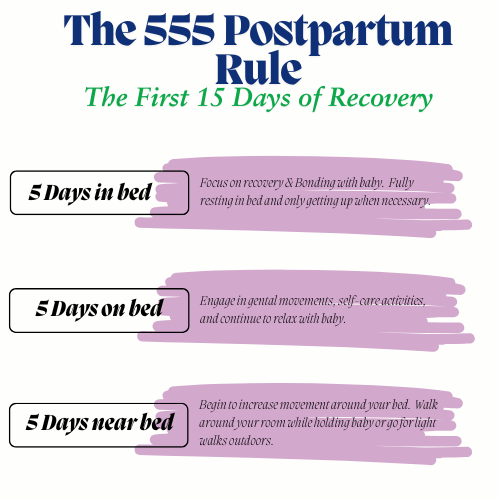
Join 130k subscribers and get the best of the week, straight to your inbox.
Childbirth is physically demanding, mentally draining, and catches us off guard with its surprises. As a mother of two, I’ve been through that post-birth haze where everything feels new yet exhausting.
After my first delivery, I used to feel completely worn out—emotionally and physically. I pushed myself harder than I should have, feeling like I had to “bounce back” right away. Now that I look back, I wish I understood that resting is necessary and I was not selfish for doing ‘nothing’ (as if birthing alone isn’t a life-changing battle).
Had I known what the 5 5 5 postpartum rule meant and how important it was for me and my child to rest, I would have enjoyed that time more. Anyway, I don’t want that for you, new mama. I want you to know what this 555 rule says and how it helps with proper healing.
If you want advice that can save you a lot of stress and tears as a new mother, let’s discuss the 5 5 5 postpartum rule.
What is the 5 5 5 Rule for Postpartum?
My first postpartum experience was all over the place—no one told me how much rest I needed, and I ended up feeling physically weak, in addition to the emotional challenges like the postpartum resentment towards my husband. I tried to do everything by myself, thinking that was the “normal” thing. But it was far from normal. Recovering from birth is a big deal, and it’s okay to slow down.
I learned what is the 5 5 5 rule for postpartum after my second baby and found it extremely helpful. Here is what the 555 rule says:

5 Days In the Bed
For the first five days after birth, the mother stays in bed as much as possible. But this doesn’t mean you can’t get up to use the bathroom or stretch; it means your primary space is your bed. The 5-day rest period helps your body recover from labor and delivery. Whether you deliver naturally or by C-section, your body needs time to heal.
Generally, the 5-5-5 rule postpartum c-section is more important since the surgery makes the mother weak, and the stitches take time to heal. But even if the mother delivers vaginally, the rest is just as important.
So when you remain in bed, you reduce strain on your muscles, ligaments, and any stitches you might have. During these days, focus on feeding and bonding with your baby. Keep supplies—diapers, wipes, bottles, or water—within arm’s reach. If you have help at home, let others manage the chores.
5 Days on the Bed
After the initial healing days, the 5 5 5 postpartum rule asks the new mom to stay on the bed. Now, you can sit up more often and move to nearby chairs or the couch, but you still prioritize rest. During this phase, you gradually increase your activity while staying in a safe zone. Your body continues to recover, and you must not sabotage the healing process.
Since you feel a bit better now, you can even do light tasks—like folding baby clothes or preparing simple snacks—but keep it minimal. The big difference from the first phase is that you’re not strictly lying down and are upright more often. But like I said, that does not mean walking around doing heavy chores. Emotionally, you might feel a bit more settled at this point because the initial shock of childbirth has passed, but hormones are still shifting.
5 Days Around the Bed
In the final five days of the 5 5 5 postpartum rule, you spend more time “around the bed” and are not stuck in one spot anymore. You can walk around the room and handle light household tasks if you feel ready. You can even step outside for a brief moment of fresh air if it feels comfortable.
This is the stage where gentle mobility helps you transition into normal life, so keep your movements slow. For example, you can carry your baby to a different room for feeding or settle on the couch instead of the bed. Such gradual change keeps you from overexerting and if you notice new pain or bleeding, take it as a sign to scale back.
Loved this reflection?
Join The Now Edit — my weekly letter for women reimagining how they live, work, and show up in the world.
Soulful storytelling. Gentle Strategy. Real Tranformation.
By signing up, you’re agreeing with our terms and conditions.
You should also monitor your energy and mood closely. If you experience any severe emotional shifts— intense sadness or anxiety, or the feeling of a bad mom because you’re not able to give enough attention to your other children—talk to a healthcare provider since postpartum depression can surface at any point, and early intervention can help.
5-5-5 rule postpartum research has shown that women who followed these rest-focused practices (including staying mostly at home/in bed and limiting household responsibilities) reported fewer physical and depressive symptoms.
Interestingly, many cultures follow similar rules, even if the term ‘5 5 5 postpartum rule’ is not specifically used. For example, according to the Chinese custom, a mother’s confinement period postnatal is called “zuo yue zi” (in simple words, sitting the month). This is the month post-birth when the mother is given complete bed rest to recover.
What are the Benefits of 5-5-5- Rule Postpartum

The 2013 Listening to Mothers survey interviewed 2,800 moms in the US to understand their experience. One of the many things these moms had to say about their life after giving birth was not knowing about the fatigue and physical challenges they’ll face postpartum. This is one of the reasons it’s important for mothers to drop everything else and just rest.
WHO guidelines also say that women should have regular postpartum checkups and feel supported at home to rest and recover. These guidelines also emphasize the point of the postpartum 555 rule that mothers benefit from reduced physical workload and plenty of rest after childbirth as it can reduce the risk of complications.
Here are some benefits a new mother can experience if she follows the 5 5 5 rule postpartum guidelines:
Faster Physical Recovery
The 5-5-5 rule can help your body bounce back faster. In the first week or two after birth, your body undergoes a lot of internal healing. Your uterus is shrinking, tissues are trying to repair themselves, and energy stores are still low. Therefore, resting and limiting movement in those first five days gives your muscles and ligaments the time they need to mend. If you had a cesarean section or any complications, this structured rest is even more critical since your body is weak.
Also Read: Pregnancy Capsule Wardrobe
Lower Risk of Postpartum Depression
Emotional healing is just as important as physical recovery. As I said before, women who experience a supportive environment after birth are less likely to show depressive symptoms. The 5-5-5 rule encourages moms to slow down and her support group to step up. It takes a village to raise a child and this period of complete rest can lower stress and reduce some of the overwhelm. Hormones fluctuate dramatically in the postpartum period, and if you’re running on empty, it’s easy to feel isolated or depressed. Prioritize your healing, darling.

Better Breastfeeding Success
The pain of failed latching attempts is something, lol. Breastfeeding is a new skill for both you and your baby, which requires patience and practice. When you’re following the 5-5-5 postpartum rule, you have more downtime to focus on proper latch techniques and consistent feeding schedules. Plus, frequent skin-to-skin contact can also boost milk supply and help your baby learn to latch.
Stronger Bonding with Baby
Bonding is a process of learning your baby’s signals, smells, and sounds. The 5 5 5 rule postpartum creates time and space for this connection to form. When you’re resting in bed with your newborn, you can focus on small cues— a change in breathing or a little facial expression—that can tell you they’re hungry or just need some cuddling. These moments build trust between you and your baby.
Taking Good Care of Herself
New mothers often put their health on the back burner but this rule reminds the mom that caring for herself is as important as it is for the newborn. Enough rest can protect you from burnout and give your mind space to adjust to sudden lifestyle changes. Taking breaks to hydrate, eat meals, and even do light breathing exercises can re-energize you in ways that benefit both you and your baby.
Do a Balanced Start of Motherhood With 5 5 5 Postpartum Rule
The 5-5-5 rule sets clear boundaries for new mothers’ rest and recovery. Having realistic goals and leaning on trusted support can protect mothers from feeling overwhelmed. Daily check-ins with oneself help maintain a calm mindset and foster a steady recovery. Some simple adjustments—like delegating tasks—can offer a new mama more breathing room. This intentional focus on healing builds a strong foundation for the journey together.
Suggested Reads:
FAQs
What are the 5 universal postpartum needs?
Many experts believe that mothers need five key things after giving birth: rest, balanced nutrition, emotional support, accurate information, and timely comfort measures.
What are some practical tips for implementing the 5-5-5 rule at home?
Preparation will help you with this. Freeze a few meals or stock up on snacks before giving birth. Also, stock up on baby essentials and keep them within reach of your primary rest area. If you can, arrange a schedule where friends or family can drop by to help with errands or chores. Limit the number of visitors in the first few weeks so you can rest without feeling overwhelmed. Communicate openly about your need for downtime.
What role do partners or family members play in supporting the 5-5-5 rule?
Loved ones can handle tasks that fall on new moms, including cooking, tidying up, or caring for older children. Such a system frees you up to focus on your recovery and the baby. They can also offer emotional support by listening and checking in on how you feel each day. Clear communication is important—tell them what you need, whether it’s help with laundry or a short nap during the day.
Zakia Lott
More Like This:








